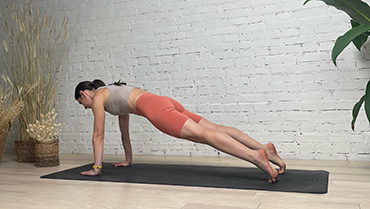Plank Pose

Contents
In Plank Pose or Phalakasana in Sanskrit, as the name suggests, the body is held in a way that looks like a plank, thin and long. In Plank Pose the emphasis is on the core muscles and shoulders strength. This pose essentially works for someone who wants to take the arms and shoulder strength to the next level in order to do more difficult arm balancing yoga poses.
Plank Pose is considered a base pose as plank pose variations can be derived from this pose. This pose helps boost energy in the body and hence can be included in flow yoga sequences.
Pose Detail
- Body Position: Arm & Leg Support
- By Type: Balancing Yoga Poses, Pregnancy Yoga Poses, Strengthening Yoga Poses, Yoga Poses For Seniors
- Difficulty: Beginners
- By Benefit: Yoga Poses For Stress Relief
Step-by-Step Instructions
Benefits and Contraindications
Strengthens the arms, wrists, and spine
Tones the abdomen
Carpal tunnel syndrome
Photo poses in different angles


Tips
Think about the front of the body drawing up towards the back of the body.
Don’t forget about your thighs – engaging the thigh muscles will also help to activate the abdominal strength you need for Plank pose.
Try squeezing a block between your thighs to feel the action of the legs drawing together
Build your strength up by practising Half-Plank with your knees on the floor. Keep a straight line from your knees to your head.
If you are new to yoga, gradually increase the time you spend on your hands in poses like Plank and Downward Facing Dog so that you can build up strength in the wrist muscles.
Modifications & Variations
- Mountain Climber Pose Flow
- Forearm Plank Variation One Leg Raised
- Plank Pose Wall
- Plank Pose One Arm Leg Lift Opposite Knee To Elbow Flow
- Plank Pose on a chair
- Knee-down Plank Pose